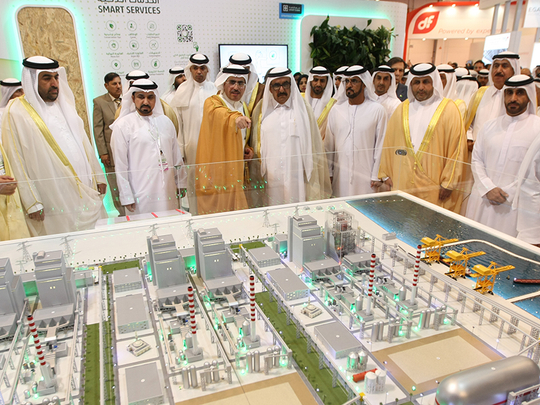
Dubai: As the UAE economy grows, the demand for energy is expected to grow by 9 per cent annually, and the government is looking to diversify energy resources, according the UAE State of Energy Report.
The first edition of this report was released on Tuesday at the first day of Water, Electricity, Energy, Technology and Environment Exhibition (Wetex) which was inaugurated by Shaikh Hamdan Bin Rashid Al Maktoum, Deputy Ruler of Dubai and UAE Minister of Finance, and President of Dewa.
According to the UAE National Agenda 2021, the share of power generation from gas will drop from 98 per cent in 2012 to less than 76 per cent in 2021 as clean energy — mainly renewable and nuclear energy — enters the mix, and energy-efficiency efforts intensify.
While the oil and gas have historically been the dominant fuels powering the UAE economy, the UAE’s energy sector is undergoing a transformation targeting the diversification of the UAE’s energy mix, the report said.
The UAE government has set a target of a 24 per cent of clean energy contribution under the National Agenda 2021. This builds on the existing renewable energy targets of Abu Dhabi at seven per cent by 2021, and Dubai at five per cent by 2030. Solar seems as the most attractive renewable technology for the UAE.
According to Saeed Al Tayer, MD and CEO of Dubai Electricity and Water Authority (Dewa), solar energy production capacity, which will be mostly produced by Shaikh Mohammad Bin Rashid Al Maktoum Solar Park, will reach seven per cent by 2019 and will be increased up to 15 per cent by 2030.
There are three key factors driving this transformation, according to the report: the aim of the UAE to extend its global energy leadership across industry spectrum; the UAE’s commitment to green and sustainable growth; and ensuring the energy security of the UAE.
The UAE’s energy sector has 27 gigawatts (GW) of installed capacity across the seven emirates, which needs 50 per cent of natural gas production, with the rest being imported, of which over 10 per cent is LNG (liquefied natural gas). Oil is only used as back-up fuel and the UAE currently doesn’t use coal as fuel, the report said.
The report highlighted another way to enhance sustainable growth for the energy sector by using the existing resource more efficiently. The UAE government is already employing several tools to cut demand.
Dubai has set a target to reduce energy consumption by 30 per cent by 2030, and Abu Dhabi’s Estidama Programme (Sustainability) is delivering 30 per cent reduction in buildings, the report said.
Ahmad Al Muhairbi, Secretary General of Dubai Supreme Council of Energy, said: “Energy efficiency is a crucial element of our strategy. For this purpose, we developed the Public Private Partnership (PPP) model to fund projects and further develop our capabilities across various technologies including solar, energy efficiency, district cooling and green building construction.”
A 100 megawatts (MW) solar project which will be commissioned in 2017, a 600MW clean coal power plant to be commissioned in 2020 with an additional 600MW in the subsequent phase and retrofitting more than 30,000 building in Dubai are some exemplar PPPs in Dubai, he said.
“We have developed a regulatory framework to attract international investment and facilitate successful projects execution,” Al Muhairbi said.










